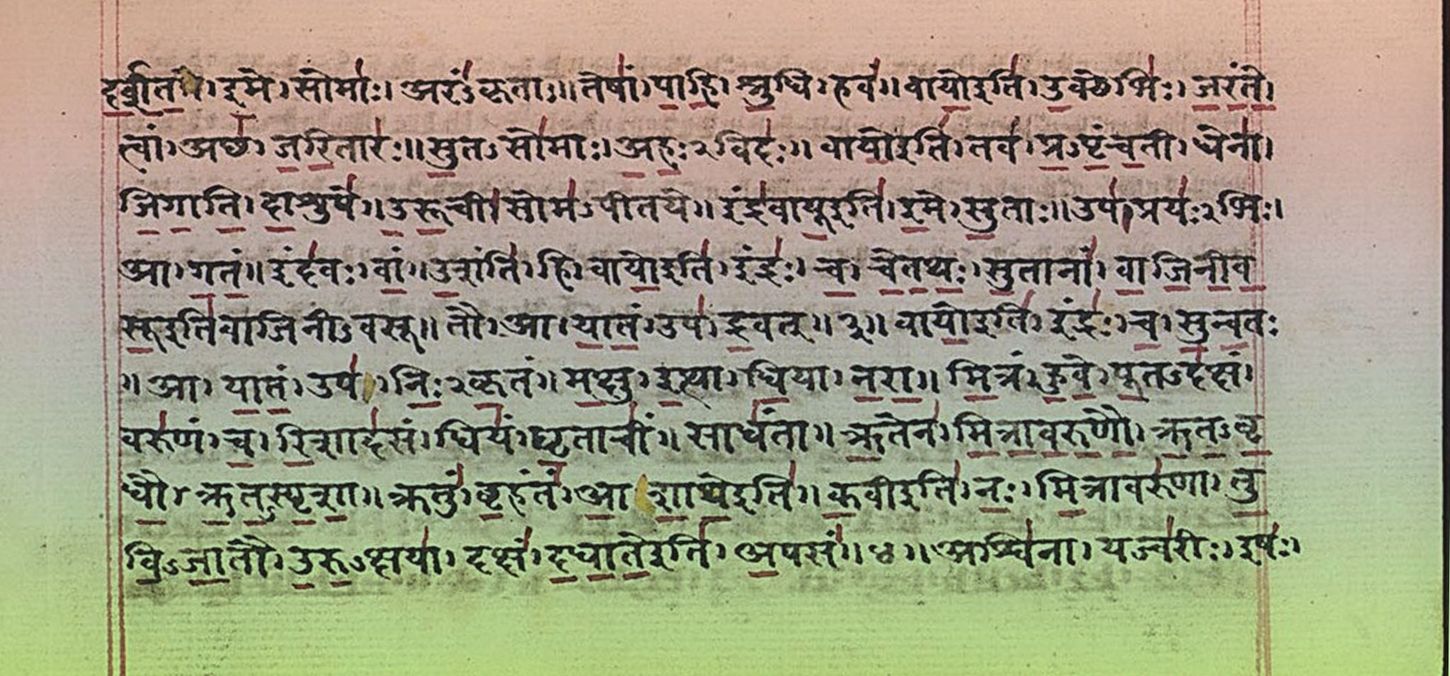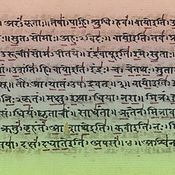
Lerne mit Dr. Ronald Steiner diesen Abschnitt genauer kennen.
Er erläutert den Sinn sowie den Text und Du kannst ihn mit ihm im Triṣṭub, Jagatī und Anuṣṭubh Metrum rezitieren.
Abschließend hast Du die Gelegenheit, den Sinnabschnitt in einer kleinen Meditation auf Dich wirken zu lassen. Hier geht es zum Video >>
Wie Feuer, eingekehrt in seine Heimstatt,
Unsichtbar fortbesteht nach seinem Wesen,
Und aus der Reibholzheimstatt neu aufleuchtet,
So flammt's, in beidem gleich26, im Leib durch Om auf.
Paul Deussen - 1897
| 26: | Das Brahman, in beidem, dem Latentfortbestehen und dem Neuaufleuchten, dem Feuer vergleichbar, kommt durch den Pranava, den heiligen Laut Om, im Leibe zum Aufflammen. |
As the form of fire, while it exists in the under-wood 5, is not seen, nor is its seed destroyed,
but it has to be seized again and again by means of the stick and the under-wood, so it is in both cases, and the Self has to be seized in the body by means of the pranava (the syllable Om).
Max Müller - 1879
| 5: | This metaphor, like most philosophical metaphors in Sanskrit, is rather obscure at first sight, but very exact when once understood. Fire, as produced by a fire drill, is compared to the Self. It is not seen at first, yet it must be there all the time; its liṅga or subtle body cannot have been destroyed, because as soon as the stick, the indhana, is drilled in the under-wood, the yoni, the fire becomes visible. In the same way the Self, though invisible during a state of ignorance, is there all the time, and is perceived when the body has been drilled by the Pranava, that is, after, by a constant repetition of the sacred syllable Om, the body has been subdued, and the ecstatic vision of the Self has been achieved. |
Den Leib machend zum Reibholze,
Und den Om-Laut zum obern Holz,
Schaut man, nach fleiß'ger Denkquirlung,
Verstecktem Feuer gleich, den Gott.
Paul Deussen - 1897
By making his body the under-wood, and the syllable Om the upper-wood, man, after repeating the drill of meditation, will perceive the bright god, like the spark hidden in the wood1.
Max Müller - 1879
| 1: | Cf. Dhyânavindûpan. verse 20; Brahmopanishad, p. 256. |
Wie im Ölsamen Öl, in Milch die Butter,
In Strömen Wasser, im Reibholze Feuer,
So findet im eignen Selbste jenen [âtman],
Wer ihn erschaut durch Wahrheit und Kasteiung,
Paul Deussen - 1897
As oil in seeds, as butter in cream, as water in (dry) river-beds2, as fire in wood, so is the Self seized within the self, if man looks for him by truthfulness and penance3;
Max Müller - 1879
| 2: | Srotas, a stream, seems to mean here the dry bed of a stream, which, if dug into, will yield water. |
| 3: | The construction is correct, if we remember that he who is seized is the same as he who looks for the hidden Self. But the metre would be much improved if we accepted the reading of the Brahmopanishad, evam âtmâ âtmani grihyate 'sau, which is confirmed by B. The last line would be improved by reading, satyenainam ye 'nupasyanti dhîrâh. |
Den alldurchdringenden âtman,
Wie Butter in der Milch versteckt,
In Selbstkenntnis, Selbst-Zucht wurzelnd,
Das Endziel der Upanishad,
– das Endziel der Upanishad.
Paul Deussen - 1897
(If he looks) for the Self that pervades everything, as butter is contained in milk, and the roots whereof are self-knowledge and penance. That is the Brahman taught by the Upanishad.
Max Müller - 1879



 Dr. Ronald Steiner
Dr. Ronald Steiner
 Nils Jacob Liersch
Nils Jacob Liersch

Nachrichten und Bewertungen